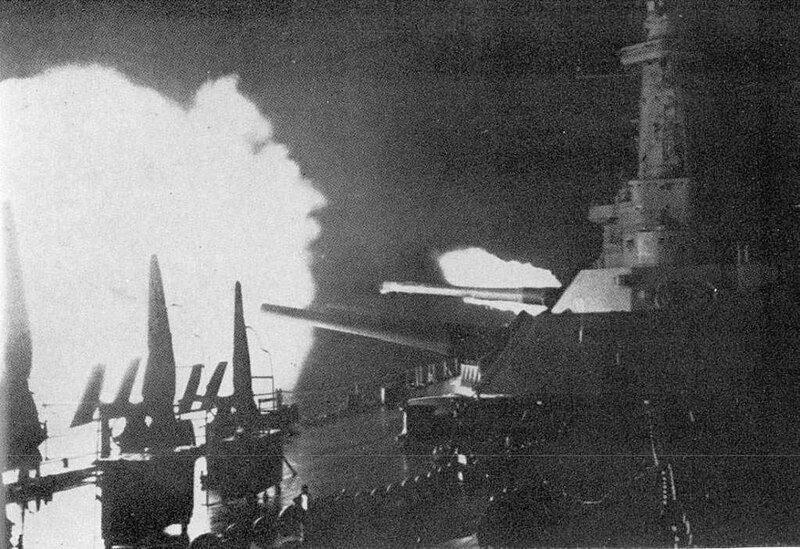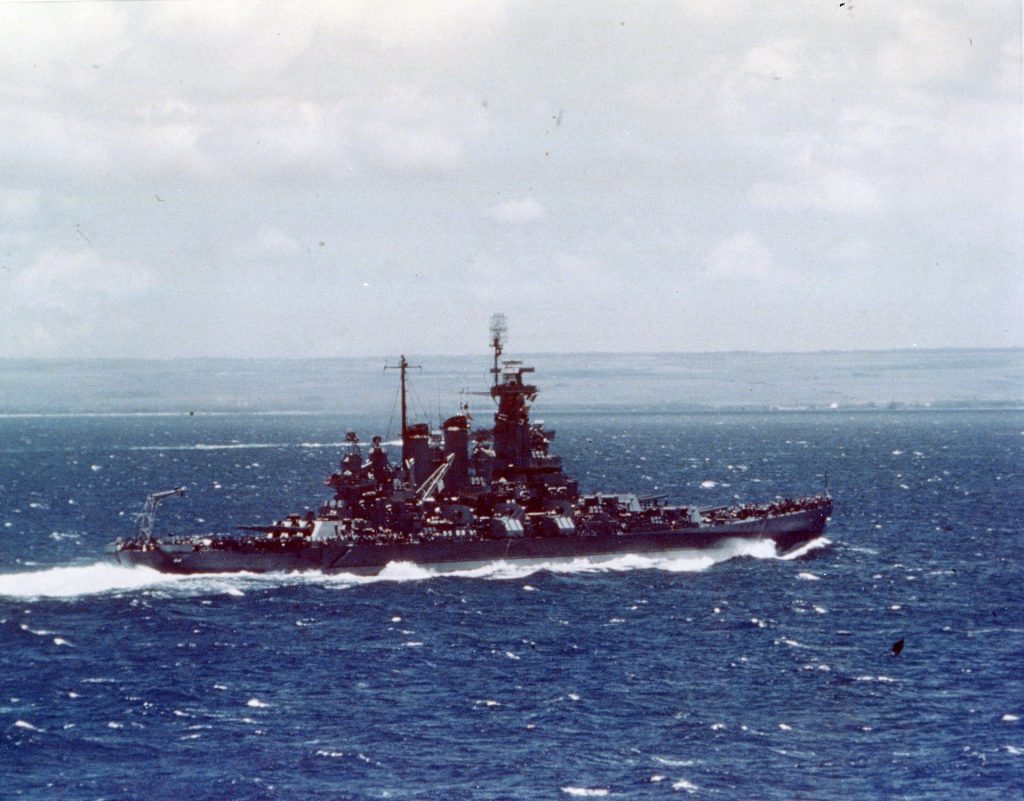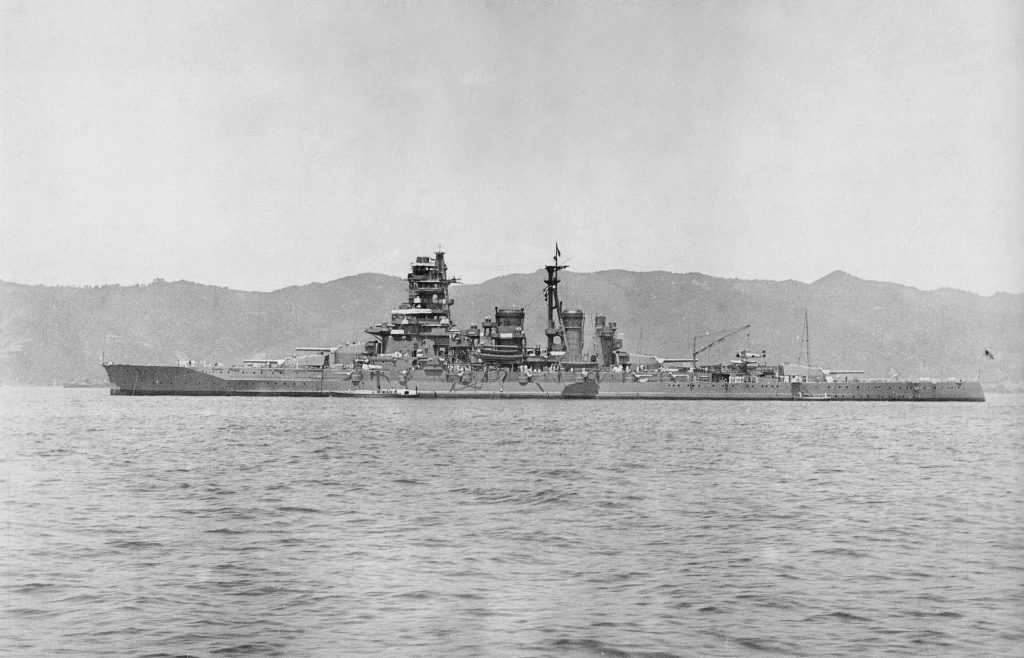The sinking of the Japanese battleship Kirishima during the Naval Battle of Guadalcanal in November 1942 was a pivotal moment in World War II’s Pacific Theater.

Engaged by the USS Washington, Kirishima suffered catastrophic damage from the Washington’s superior radar-guided gunfire, highlighting the impact of technological advancements in naval warfare.
The loss of Kirishima not only weakened Japanese naval capabilities in the region but also marked a significant shift in naval power towards the United States in the Pacific.
USS Washington (BB-56)
The USS Washington, commissioned in 1941, was a vital component of the United States Navy during World War II. As a North Carolina-class battleship, it represented a significant shift in American naval power and design philosophy.
This class of battleships was a response to the limitations imposed by earlier naval treaties and the evolving naval strategies of the time.
The Washington was equipped with formidable armament, most notably its nine 16-inch guns arranged in three triple turrets, which were capable of inflicting severe damage at long ranges. Additionally, the battleship carried an array of 5-inch, 1.1-inch, and .50 caliber guns for anti-aircraft and close-range defense. This heavy armament was balanced with substantial armor plating, making the Washington a formidable opponent in naval engagements.
 USS Washington manoeuvring off Hawaii in 1943.
USS Washington manoeuvring off Hawaii in 1943.
The design of the USS Washington took into consideration the need for speed and agility, factors that were becoming increasingly important in naval warfare.
With a top speed of over 27 knots, it was able to keep pace with the fast-moving carrier groups of the time.
The Washington played dual roles in both the Atlantic and Pacific Theaters
. In the Atlantic, its presence served as a deterrent against potential threats from the German Navy, while in the Pacific, it was actively involved in several key engagements against Japanese forces.
Kirishima
The Kirishima, originally a Kongo-class battlecruiser, was one of the Imperial Japanese Navy’s earliest capital ships.
Commissioned in 1915, it underwent significant upgrades in the 1930s, transforming it into a fast and heavily armed battleship.
These modifications were part of Japan’s broader efforts to modernize its fleet in anticipation of future naval conflicts.
The upgrades included enhanced armor, improved engines for greater speed, and an updated array of weaponry.
Kirishima’s main armament consisted of eight 14-inch guns, complemented by a secondary battery of 6-inch guns and an array of anti-aircraft guns and torpedoes.
The role of Kirishima in the Japanese Navy was multifaceted.
As a battlecruiser turned battleship, it was expected to engage enemy capital ships, protect aircraft carriers, and support amphibious operations.
Its speed and firepower made it suitable for a range of missions, from fleet engagements to independent operations.
Kirishima’s participation in several key battles in the Pacific, including the attack on Pearl Harbor and various engagements in the Solomon Islands, underscored its strategic importance to the Japanese naval strategy.
The Battle Of Guadalcanal
The Battle of Guadalcanal, spanning from August 1942 to February 1943, was a critical campaign in the Pacific Theater of World War II.
This lengthy and multifaceted battle represented the first major offensive by Allied forces against the Empire of Japan.
Guadalcanal, located in the Solomon Islands, was strategically significant due to its position along key sea routes between the United States, Australia, and New Zealand.
Control of these routes was crucial for maintaining supply lines and for the movement of Allied forces.
Central to the importance of Guadalcanal was Henderson Field, an airfield that had the potential to control the airspace over the Solomon Islands and the surrounding sea areas.
The Japanese sought to use this airfield to threaten Allied shipping and disrupt supply and communication lines.
Conversely, for the Allies, holding Henderson Field was essential for launching air operations against Japanese positions and for protecting their own logistical movements in the region.
 USS Washington firing at night during the Naval Battle of Guadalcanal.
USS Washington firing at night during the Naval Battle of Guadalcanal.
The Guadalcanal Campaign was characterized by its combined arms nature, involving fierce land battles, naval engagements, and aerial clashes.
The land battle was marked by brutal jungle warfare, with both sides facing not only each other but also challenging terrain and harsh tropical conditions.
The naval battles around Guadalcanal were some of the most intense and significant of the Pacific War.
These included several major engagements, such as the Battle of the Eastern Solomons in August 1942 and the Battle of Santa Cruz Islands in October 1942, leading up to the critical Naval Battle of Guadalcanal in November.
The Naval Battle of Guadalcanal, in particular, was a decisive element of the campaign.
It was a series of engagements that occurred from November 12 to 15, 1942, and involved several intense night battles.
These battles were marked by close-range combat and were some of the most brutal naval engagements of the war, characterized by a combination of gunnery, torpedo attacks, and the significant use of radar, which was still a relatively new technology in naval warfare.
The Sinking Of The Kirishima
The Naval Battle of Guadalcanal, a crucial segment of the broader Guadalcanal Campaign, unfolded over several days in November 1942.
This battle was not a singular engagement but a series of complex and fiercely contested naval clashes.
The Japanese objective was to reinforce their troops on Guadalcanal and to destroy Henderson Field, the critical airfield that the Allies were using to disrupt Japanese operations in the region.
To achieve this, the Japanese planned a significant bombardment of the airfield using the battleship Kirishima, accompanied by cruisers and destroyers.
The United States, aware of the Japanese plans through intelligence and reconnaissance, dispatched a task force including the battleship USS Washington and the USS South Dakota, along with a protective screen of destroyers, to intercept the Japanese fleet.
The battle is particularly notable for its intense night engagements. On the night of November 13th, an initial clash occurred, resulting in heavy losses for the U.S., including the sinking of several cruisers and destroyers.
This initial engagement, however, did not deter the U.S. Navy, and they continued to contest Japanese attempts to reach Guadalcanal.
The most crucial phase of the battle occurred on the night of November 14-15. The USS Washington and Kirishima faced each other in what would become one of the most significant duels of the Pacific War.
In the darkness of the early hours, the two battleships, along with their accompanying vessels, engaged in a fierce battle marked by intense gunfire and torpedo exchanges.
 The Japanese battleship Kirishima, pictured in 1937.
The Japanese battleship Kirishima, pictured in 1937.
A key factor in this battle was the use of radar, which the USS Washington had and effectively utilized.
The radar allowed the Washington to detect, target, and engage the Japanese ships at a distance and in the dark, a significant advantage over the Kirishima, which lacked this technology. The Washington’s radar-guided gunfire proved to be devastatingly effective.
In a demonstration of superior gunnery and tactics, the USS Washington engaged the Kirishima with its powerful 16-inch guns.
The Washington’s accurate and rapid fire inflicted severe damage on the Kirishima, which suffered multiple hits that compromised its structural integrity and rendered it incapable of effective combat.
This intense shelling led to the eventual sinking of Kirishima in the early hours of November 15th.
The sinking of the Kirishima marked a critical point in the Naval Battle of Guadalcanal. It was a significant blow to the Japanese, both materially and in terms of morale.
The loss of Kirishima, one of their few battleships in the Pacific, limited the Japanese Navy’s ability to project power and challenge American sea control.
This battle exemplified the changing nature of naval warfare. The effectiveness of radar-guided gunfire, the importance of night-fighting capabilities, and the value of modern battleship design and firepower were all highlighted.
The USS Washington’s victory over Kirishima demonstrated not only the tactical proficiency of the U.S. Navy but also the strategic implications of technological superiority in naval engagements.





